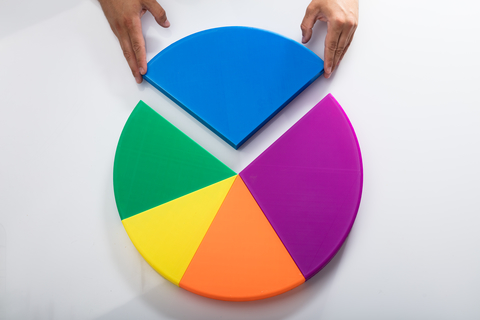Many of my clients have questions about their PPC program goals.
Should they only set goals that are directly related to leads and sales?
Or should they also set goals that are related to brand building?
And if they’re doing well with leads and sales, wouldn’t it make sense to put all of their focus there?
Not necessarily.
When you consider the health of your PPC program (and your business overall), you need to take a balanced approach.
And to explain what I mean, I like to use financial portfolio management as a metaphor.

“Asset Allocation” in PPC Program Management
Asset allocation is a major tenant of wise portfolio management. In simple terms, asset allocation means dividing your investment dollars among different asset classes, such as stocks, bonds, cash, real estate, etc.
Ultimately, the goal is to select the right mix and proportion of asset classes based on your financial goals, risk tolerance, time horizon and other factors.
The ideal asset mix will vary as these factors change. At different times, you will invest more heavily in one type of class than another. But you should never put all of your eggs in one basket!
In other words, if a particular asset class is performing strongly, that doesn’t mean you should sell out of every other asset class and sink all of your dollars into the hot performer. If stocks are soaring, for example, don’t sell all your bonds to buy new stocks!
Financial professionals understand that markets can change quickly. So to minimize risk (while still getting a healthy return) they aim to achieve balance within your portfolio.
The same principles apply to PPC.
Just because your brand campaigns are performing well, that doesn’t mean you should stop running non-brand campaigns, and vice versa.
Again, the goal is to achieve balance and minimize risk by allocating your PPC budget wisely.
Next, let’s look at each of these PPC goals—brand and non-brand—more closely.
Brand Goals
Isn’t it great when people search for your brand by name and then go on to buy your product or service?
That’s what brand goals are all about.
If you’re a new company or launching a new product, you have nowhere to go but up with your brand goals! People don’t know you yet, so it’s your job to introduce yourself.
As people get to know you, you can expect your brand goals to grow—and continue to grow.
If your brand traffic has been holding steady for a long period of time (e.g. one year), you might think that’s a good thing. It’s not, necessarily.
You should continue to experience growth every year (and preferably every month). If you’re not, it’s time to ramp up your brand awareness activities through non-branded search, Shopping campaigns and the GDN.
And if your brand traffic starts to fall, that’s a serious red flag! Start working immediately to build your brand traffic through the methods mentioned above and do some analysis and research to see what’s going on.
Otherwise, you might see a serious drop in leads and sales.
Non-Brand Goals
Your non-brand advertising is what builds your brand. It’s just as important as your brand advertising.
Non-brand advertising is when you bid on keywords that describe your products or services, rather than your brand name.
You’ll likely find that your non-branded campaigns convert at a much higher cost than your brand campaigns. That’s normal. Typically, there’s more competition for descriptive keywords than brand name keywords.
Some marketers will stop non-brand advertising because of those high costs. But this is dangerous.
I understand that performance-focused marketers want to keep their CPAs as low as possible. But at the same time, these seemingly expensive non-brand conversions deliver more value than you might think.
For example, those clicks contribute to:
- Brand building
- New visitors to your site
- New visitors into your marketing funnel
- New visitors at the top of your funnel
- Intelligence on what people are looking for
- Less real estate for competitors.
This article in Acquisio says it best:
While non-branded terms will be much more competitive and expensive, they are needed to capture the top-of-the-funnel traffic. The truth is that without a constant influx of top of the funnel traffic, you might not have as much bottom of the funnel traffic or searches for your brand. If people can’t discover you, they won’t be searching for branded terms.
This is important stuff! So don’t let higher CPAs convince you to give up on your non-brand goals.
Troubleshooting
If you’re not getting any results from your non-brand efforts, make sure you’re not giving attribution for conversions to the last keyword that was clicked.
The “last click” attribution model can make it look like all of your conversion are being driven by brand ads and non-brand ads are doing nothing.
But really, it’s a problem of attribution and not a problem with your non-brand ads.
You can learn more about attribution settings in an article I wrote for Search Engine Journal.
Nick Altman also provides a good explanation in MetricTheory.
You also have the option of locking down your targeting further if your CPAs are particularly high. For example, you can use in-market audiences to get even more specific.
Don’t “Invest” in Just One Type of Campaign
Just as you should never put all your money into one asset class while ignoring the rest, it’s important to support both brand and non-brand goals.
This doesn’t mean you have to allocate equally. But you should always allocate something. And you can adjust those percentages depending on your business, goals and results.
Because as I’ve said before, both brand and non-brand goals are important. And they work best when they’re in harmony.






